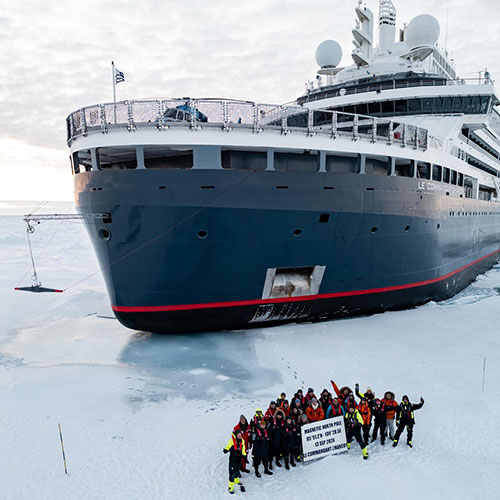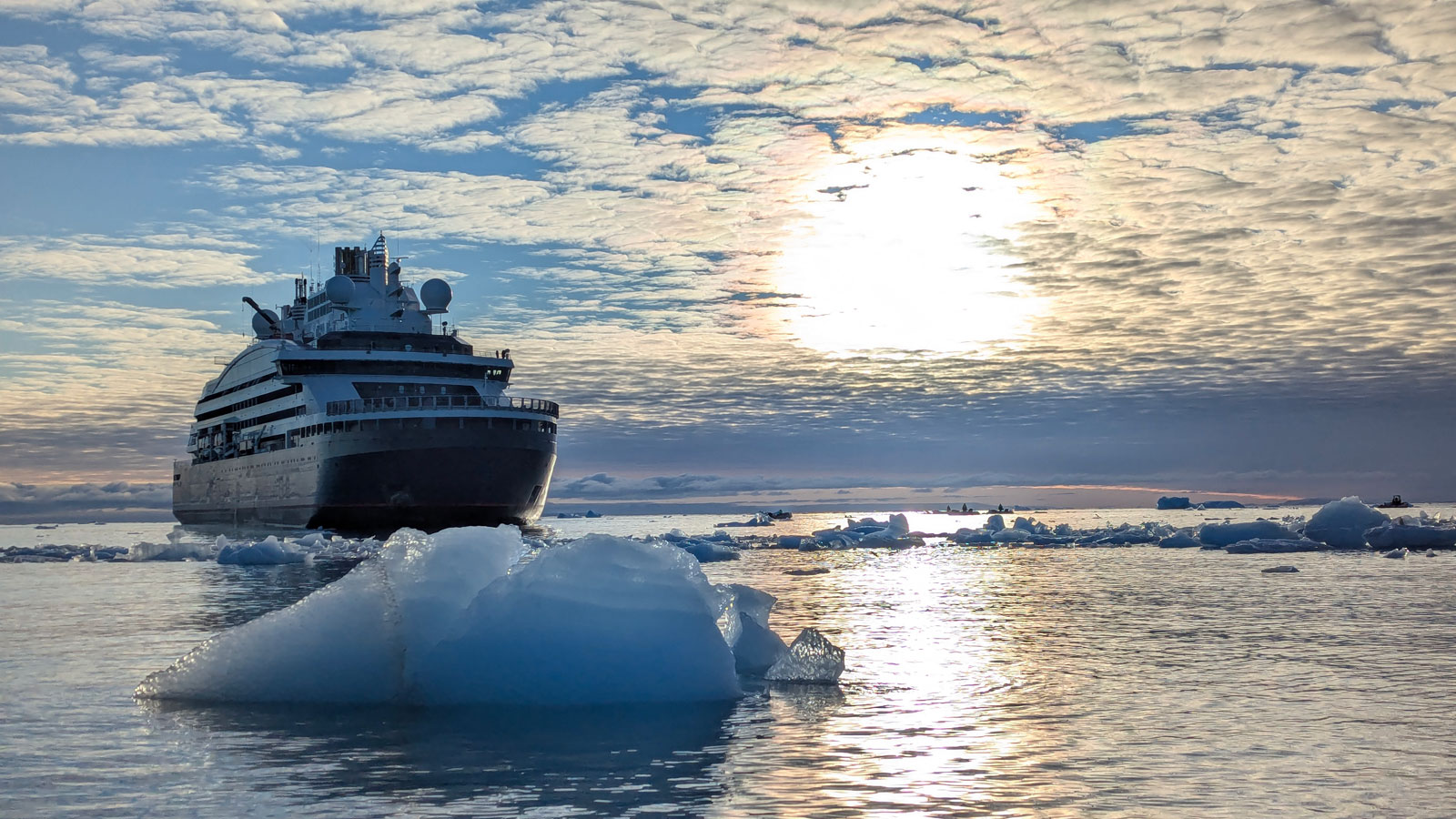The air and surface temperature tip just above freezing.
Cruiseliner Ponant’s 492-ft vessel Le Commandant Charcot floats idle at marked coordinates in the Arctic tundra between Alaska and Norway. On the aft deck, a team of scientists deploys Niskin bottles using a handcrank to the depths, collecting water samples 900 meters below an ocean blanketed with sheets of ice in all directions.

Leticia Barbero, Ph.D., a principal investigator with the Ocean Carbon Cycle group at NOAA’s Atlantic Oceanographic & Meteorological Laboratory (AOML) and a scientist with the University of Miami’s Cooperative Institute of Marine and Atmospheric Studies (CIMAS), traversed the Arctic aboard the ship Le Commandant Charcot. An icebreaking cruise ship, Le Comandant Charcot departed from Nome, Alaska heading to the magnetic North Pole and finally to Svalbard, Norway with a group of 20 scientists from eight countries and over 200 passengers.
While others investigated microplastics, ice cores, and environmental DNA, Leticia collected data as part of the International Ships of Opportunity Program to monitor the global ocean’s uptake of carbon – and ultimately rising acidification in one of the world’s most remote regions.
Carbon dioxide, like all gasses, diffuses between the atmosphere and the ocean. With rising levels of carbon dioxide in the atmosphere, the ocean accumulates more carbon through air-sea gas exchanges as part of its natural cycle. However, rising levels of carbon in the ocean has consequences – and one of them is ocean acidification.

Tracks where Ships of Opportunity surface CO2 data has been collected.
“We need better quantification of the fate of the anthropogenic carbon dioxide we release in the atmosphere if we want to be able to mitigate its effects on the climate,” says Denis Pierrot, Ph.D., Principal Investigator at AOML with the Ocean Carbon Cycle group.
Through partnerships with the Compagnie du Ponant and other cruiseliners, cargo vessels, sailboats, and moorings across private industries, the Ships of Opportunity Program, led in large part by scientists at AOML, enables researchers to track this exchange on a global scale.
An effort supported by NOAA’s Global Ocean Monitoring and Observing program (GOMO), the vast swaths of data collected, quality-controlled and published in the Surface Ocean CO2 Atlas (SOCAT) since these measurements started in the 1960s means researchers across institutions can examine how the ocean’s accumulation of carbon varies regionally, globally, and over years and decades.
However, one region remains understudied where fewer vessels are able to travel and where ocean acidification is occurring faster than the global ocean: the Arctic.

Polar bears along the ship’s path

Le Commandant Charcot emerging beyond an iceberg

Leticia Barbero, Ph.D. collecting seawater samples through the ice
With an estimated 245 passengers onboard, the Charcot crew navigated the frigid waters, supporting both entertainment and the ongoing research. “It was fantastic,” said Barbero. “And the company was very willing to help the scientists and be adaptable – especially when getting samples.”

The pCO2 Underway system installed and maintained by scientists at AOML measures the surface ocean’s uptake of carbon in near-real time.
In the Charcot’s Wetlab, filters, gas selection valves, and weather sensors merge into a system reading the partial pressure of carbon dioxide (pCO2) in the ambient air and surface waters as the ship and its passengers cruised towards the North Pole. Barbero spent the three weeks onboard running the pCO2 underway system with assistance from the ship’s science support crew as the data was transmitted daily via a satellite modem. The system, installed in April 2022 by scientists at AOML measures the surface ocean’s carbon dioxide concentration continuously as seawater is pumped through it – that is, as long as the pumping system can be kept free of ice, something that is hard to do when the ship is in motion.
To further validate the system’s readings and investigate the Arctic Ocean’s chemistry, Barbero and the team of researchers deployed both CTD and handheld Niskin bottles at predetermined stations along the cruise track, collecting seawater samples at multiple depths from the surface to 900 meters below. And when the ship sat idle, they ventured onto the ice.
Passengers watched and asked questions as researchers and the support crew punched small holes in the ice to collect water samples. “We’re really curious how the pH values in the ice compared to samples collected with the CTD and the Niskin bottles,” says Barbero.


By analyzing these samples back at AOML’s Carbon Lab, the team can measure the pH, alkalinity, and dissolved inorganic carbon as an indicator of ocean acidification, quantify nutrient concentrations that may be encouraging harmful algal blooms in the Arctic, salinity and other key parameters.
Adding to the global array of ships and moorings equipped with pCO2 sensors under the Ships of Opportunity Program, this data builds on an expanding network known as the Surface Ocean CO2 Reference Observing Network (SOCONET) that quantifies the fluctuation of carbon between surface waters and the lowest layer of the atmosphere, the marine boundary layer.
“We are expanding our network SOCONET in the context of the international World Meteorological Organization (WMO) Global Greenhouse Gas Watch (G3W) initiative to meet these goals,” says Denis Pierrot, Ph.D. “And our partnerships with cruiseliners such as the Compagnie du Ponant are essential to our effort, especially in areas where data is sparse like the Arctic.”

Ultimately a part of the Global Ocean Observing System (GOOS), the expansion of SOCONET allows scientists to monitor the ocean’s sequestration of carbon by more holistically capturing the air-sea gas exchange across time and space – a key factor in determining the annual Global Carbon Budget.
The global ocean has taken up an estimated 26% of anthropogenic carbon – roughly 681 billion metric tonnes of carbon dioxide – emitted into the atmosphere since 1850, effectively mitigating its global warming effect on the climate but also resulting in more acidic waters. In the Arctic, studies suggest sensitivities among key commercial fish species such as the Pacific Cod to rising ocean acidification, making this global effort all the more critical.

the Le Commandant Charcot behind them
